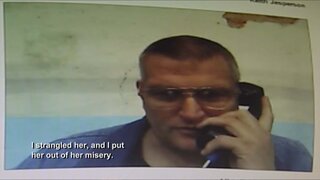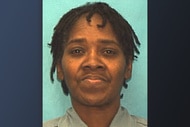Create a free profile to get unlimited access to exclusive videos, breaking news, sweepstakes, and more!
These Are Some of the Most Notorious Female Serial Killers
Studies indicate that most female serial killers choose non-violent methods of killing their victims.
Ask anyone to name a serial killer and chances are that they will come up with a short list — of all male serial killers.
But that's not to say that women have never been serial killers. At least 8% of serial killers are women, according to a study from the University of Michigan, which also notes that a majority of these criminals killed for financial gain.
Female serial killers also differ from their male counterparts in that they're less likely to murder in violent, bloody ways. The University of Michigan study found that these killers will often target weak, vulnerable acquaintances or family members using methods such as poison, whereas men are more likely to kill strangers.
RELATED: The Zodiac Killer's Identity Is Investigated in Myth of the Zodiac Killer Trailer
Penn State researcher Marissa A. Harrison wrote in the book Just as Deadly that most female serial killers are medical serial murderers. In fact, about 39% of female serial killers were nurses or health care workers, like Elisabeth Wettlaufer and Kristen Gilbert, both of whom make our list of notable murderers.
Elizabeth Wettlaufer
Born Elizabeth Parker, this Canadian health care worker was responsible for eight patient deaths between 2007 and 2014, and tried to kill six more.
Through her career, which began in the 1990s, Wettlaufer had showed signs of mental health issues and lapses in judgment, but the Ontario Nurses’ Association (ONA) sought to rehabilitate the nurse instead of revoking her license, according to Chatelaine. She was fired from the Geraldton District Association for Community Living in 1995 for stealing prescription drugs and enrolled in an addiction treatment program, the outlet reported. In light of her struggles, the ONA allowed Wettlaufer to state on her resume that she had quit and taken a leave of absence, meaning that future employers were unaware of her record.
Unaware of Wettlaufer's previous disciplinary record, she continued working in nursing homes, where she'd again begin to struggle with the stresses of the job and begin fantasizing about hurting patients. By 2006, Wettlaufer was again disciplined for botched medication dosages and "emotionally abusing patients," Chatelaine reported.
At the time, she sought help and checked into a psychiatric facility, where she was diagnosed with depression and borderline personality disorder. Though she was given medication to treat her conditions, these fantasies returned when she began working at another care facility, she later told investigators, according to Chatelaine.
At the nursing home Caressant in Woodstock, Ontario, she began testing what would happen if she administered doses of insulin to patients, beginning with 86-year-old Clotilde Adriano and Albina Adriano, 88. She described this impulse to investigators as being a "red surge" that took over her, the CBC reported.
Then, she began killing people, beginning with James Silcox, 84. Her other victims include Maurice Granat, 84; Gladys Millard, 87; Helen Matheson, 95; Mary Zurawinski, 96; Helen Young, 90; and Maureen Pickering, 79, and Arpad Horvath, 75.
Since the victims were elderly and weak, their families had assumed they died of natural causes. And while Wettlaufer apologized and confessed to her crimes, many loved ones have stated they can't forgive her. As Horvath's daughter Susan told the CBC, "I'm not going to forgive her for nothing, she knew what she was doing."
Kristen Gilbert
Another serial medical murderer is Kristen Gilbert, a Massachusetts nurse convicted of three counts of first-degree murder, one count of second-degree murder, and two counts of attempted murder. However, it's speculated that the mother of two killed many more during her tenure at the Veteran Affairs Medical Center in Northampton, Massachusetts, from 1989 to 1996.
In fact, so many patients died of heart attacks under her care, her coworkers referred to her as "The Angel of Death," according to the Los Angeles Times. She was eventually caught when her coworkers reported her for stealing vials of epinephrine.
It's believed that Gilbert caused the heart attacks by injecting the patients with epinephrine, which is difficult to detect in an autopsy.
Prosecutors argued during the trial that Gilbert, then only 33, had killed her victims, all of whom were veterans, because she got a "thrill" from the sense of emergency it created in the hospital.
Aileen Wuornos
This Florida woman is one of the most well-known female serial killers in American history.
Born to a broken family, Wuornos had a troubled childhood and left home at a young age to escape alleged abuse. To make ends meet, she turned to sex work while living in Florida, where she began killing men.
Initially, Wuornos claimed that she killed her first victim, Richard Mallory, in self-defense in December 1989. She told investigators that Mallory had gotten violent with her during their sexual encounter and she had no choice but to shoot him.
However, her claims of self-defense were weakened by the fact that her other victims — David Spears, 43; Charles Carskaddon, 40; Peter Siems, 65; Troy Burress, 50; Charles Richard Humphreys, 56; and Walter Jeno Antonio, 62 — had all been shot multiple times.
RELATED: Who Is The Most Prolific Serial Killer In History? Everything We Know About Samuel Little
The killings all took place within the span of a year and with each new body, police grew increasingly eager to catch the killer. Fortunately, they were aided in their endeavors by Wuornos' own girlfriend, Tyria Moore, who agreed to wear a wire and confront Wuornos about the murders.
Following her arrest, Wuornos pleaded not guilty to the murder of Mallory and insisted that she had been raped. But after being convicted of Mallory's murder, she pleaded no contest to five other murders, with the exception of Siems', according to CNN.
Though Wuornos had fought the death sentence at first, she eventually welcomed her sentence. "There's no chance in keeping me alive or anything, because I'd kill again. I have hate crawling through my system," she said, according to CNN.
She was executed in 2002.
Dorothea Puente
In the 1980s, this seemingly kind elderly woman preyed on the homeless and needy, inviting them into her unlicensed boarding home in Sacramento, before killing them and cashing in on their Social Security benefits. Though she was only convicted of killing three people, it's believed this black widow killed many more.
Puente was only caught after one of the homeless men she killed, Alvara Montoya, was reported missing by a social worker. When cops arrived at Puente's home, they noticed that the backyard appeared to recently be dug in, according to Sac Town Magazine. As police searched the property, Puente made a break for it and went to Los Angeles, where she attempted to swindle another pensioner who noticed her and turned her in to police.
Police believe that she killed at least nine people, but prosecutors only got convictions for three. She was sentenced to life in prison without the possibility of parole.
She maintained her innocence until her death in 2011.
To learn more about the murders and her capture, watch Murders at the Boarding House on Oxygen.
Juana Barraza
This unsuspecting luchador is considered the first official serial killer in Mexico, terrorizing the country in the early 2000s by murdering elderly woman in their homes.
Born to a sex worker and abandoned in her youth, Barraza told police that she killed elderly women because of the anger she held toward her mother. "I hated old women because my mom mistreated me. She always cursed me. She gave me away to an old man and I was abused," she told reporters in 2016.
Barraza purportedly posed as a social worker and befriended elderly woman in Mexico City, convincing them to allow her into their homes. Once behind closed doors, she'd strangle and beat them to death, occasionally taking items of religious significance in the process.
As police searched for the suspect, initially described as a transvestite nurse by authorities, Barraza performed in lucha libre wrestling matches.
She was later caught by police after a victim's tenant walked into the home moments after Barraza had committed the act. The tenant pursued Barraza, who was later arrested and convicted of at least 11 murders, according to The Guardian.
Karla Homolka
In 1993, this young Canadian woman came forward to police, telling them that she and her husband, Paul Bernardo, had sexually assaulted and murdered four young women. She contended that she hadn't wanted to partake in the criminal acts, but had done so because she feared Bernardo, Buffalo News reported in 1995.
Among the four victims was Homolka's own sister, Tammy, whose death on Christmas Eve 1990 was initially ruled an accident. Prosecutors said in court that Homolka confessed to offering her 15-year-old sister to Bernardo as a sexual gift, according to the Washington Post. To subdue the teen, Homolka stole the sleeping drug Halcion from work and put it in her sister's food that evening, so that Bernardo could later sexually assault the teen, the outlet reported. The combination of the sleeping medication and alcohol caused Tammy to vomit, after which she began choking and died.
Their second murder victim was 14-year-old Leslie Mahaffy, whose body was found in a lake on June 29, 1991, the same day that Bernardo and Homolka got married. Her body had been dismembered and encased in cement before being disposed of, the Washington Post reported.
It's believed that Homolka and Bernardo's final victim was 15-year-old Kristen French. Bernardo and Homolka lured the teen to their home in April 1992, subjecting her to days of torture. They later dumped her body in a remote area,
Homolka pleaded guilty to two counts of manslaughter and was sentenced to 12 years in prison as part of a plea deal that required her to testify against Bernardo. This deal would later cause outrage when the public learned that Bernardo's lawyer, Ken Murray, had withheld video footage — which has since been destroyed — of Bernardo and Homolka torturing and sexually assaulting Tammy, Mahaffy, and French, according to the CBC.
Homolka was freed from prison in 2005, while Bernardo remains behind bars, having been convicted on nine charges, including two counts of first-degree murder for the deaths of French and Mahaffy.
Joanna Dennehy
Dennehy became the first English woman to be sentenced to life in prison after murdering three men from in 2013.
It's believed that Dennehy, a mother of two from Cambridgeshire, began killing in March 2013. Her first target was Lukasz Slaboszewski, a 31-year-old Polish man whom Dennehy pretended to be romantically interested in. However, when he arrived at the destination, Dennehy stabbed him, The Guardian reported.
That same month, Dennehy stabbed housemate John Chapman, 56, and landlord, Kevin Lee, 48.
Her killing spree came to an end in April 2013, when she was arrested for stabbing strangers John Rogers, 64, and Robin Bereza, 57, as they walked their dogs, the BBC reported. Rogers, whose lungs were punctured, was left to die, while Bereza was able to walk back to his home, having been stabbed in the shoulder and chest.
She pleaded guilty to three counts of murder and two counts of attempted murder.
A psychiatrist said that she told them she began killing to "to see if I was as cold as I thought I was. Then it got moreish and I got a taste for it," the Guardian reported.
Dennehy, whose case was covered in Oxygen's Living with a Killer, remains one of only two English women to be sentenced to life in prison.





































